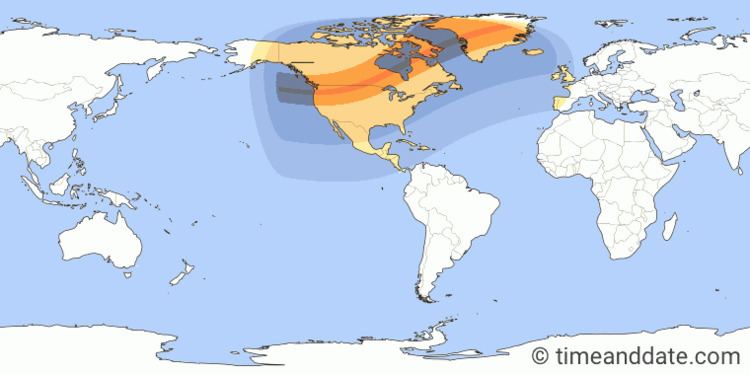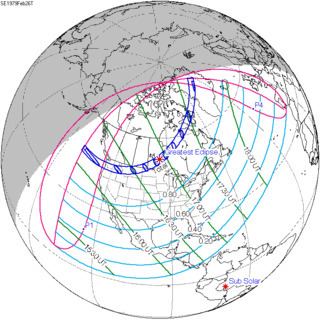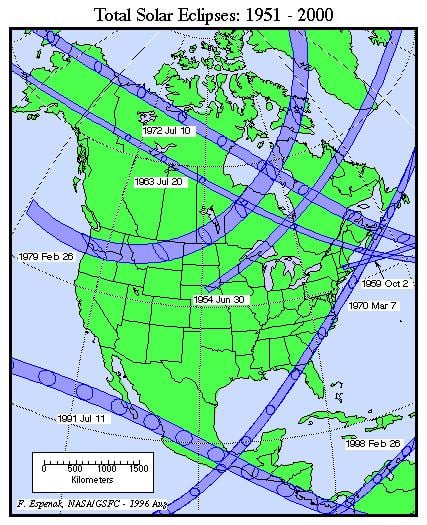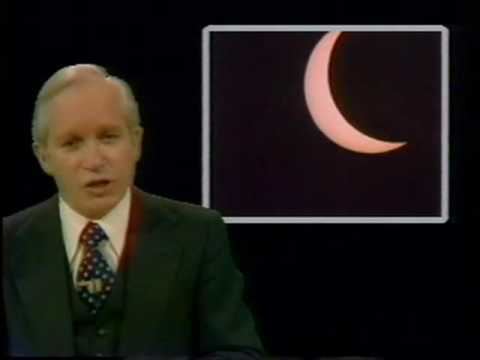Nature Total Magnitude 1.0391 Max. width of band 298 km (185 mi) Start date February 26, 1979 | Gamma 0.8981 Duration 169 sec (2 m 49 s) Greatest eclipse 16:55:06 | |
In astronomy, a total solar eclipse occurred on February 26, 1979. A solar eclipse occurs when the Moon passes between Earth and the Sun, thereby totally or partly obscuring the image of the Sun for a viewer on Earth. A total solar eclipse occurs when the Moon's apparent diameter is larger than the Sun's, blocking all direct sunlight, turning day into darkness. Totality occurs in a narrow path across Earth's surface, with the partial solar eclipse visible over a surrounding region thousands of kilometres wide. The central shadow of the moon passed through the northwestern U.S. states of Washington, Oregon, Idaho, Montana (where totality covered almost the entire state), the north-central state of North Dakota, parts of the Canadian provinces of Saskatchewan, Manitoba, Ontario, Quebec, and what is now the Canadian Territory of Nunavut, and Greenland.
Contents

Visibility

Many visitors traveled to the Pacific Northwest to view the eclipse, since it would be the last chance to view a total solar eclipse in the United States for almost four decades. The next over the United States will be the total solar eclipse of August 21, 2017.

Although the path of totality passed through Portland, Oregon in early morning, it was not directly observable from the Portland area due to overcast skies.
The path of totality passed through Winnipeg, Manitoba in the early afternoon.
Related eclipses

A partial lunar eclipse occurred on March 13, 1979, 15 days later, visible over Africa, Europe and Asia. A total lunar eclipse followed on September 6, 1979.
Solar eclipses of 1979–1982

Each member in a semester series of solar eclipses repeats approximately every 177 days and 4 hours (a semester) at alternating nodes of the Moon's orbit.
Saros 120
It is a part of Saros cycle 120, repeating every 18 years, 11 days, containing 71 events. The series started with partial solar eclipse on May 27, 933 AD, and reached an annular eclipse on August 11, 1059. It was a hybrid event for 3 dates: May 8, 1510, through May 29, 1546, and total eclipses from June 8, 1564, through March 30, 2033. The series ends at member 71 as a partial eclipse on July 7, 2195. The longest duration of totality was 2 minutes, 50 seconds on March 9, 1997.
Metonic cycle
The metonic series repeats eclipses every 19 years (6939.69 days), lasting about 5 cycles. Eclipses occur in nearly the same calendar date. In addition the octon subseries repeats 1/5 of that or every 3.8 years (1387.94 days).
